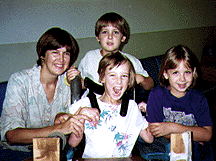Problems Associated with CP
In addition to problems controlling their muscle movement, children with Cerebral Palsy may have some other problems too. Most of these are caused by the same brain injury that caused the CP.
Talking and Eating
Just as CP can affect the way a person moves their arms and legs, it can also affect the way they move their mouth, face and head. This can make it hard for the person to talk clearly and to bite, chew and swallow food. If you meet a girl with CP you may notice that her speech is hard to understand or that she seems to work very hard just to get out a few words. This is because she is not able to make her lips, jaw and tongue move as quickly as you can. She may also have trouble controlling her breath flow to make her voice work. All of these parts of your body are very important in talking.
 Try this: Make a “g” sound (say “guh”). To do that, you must pull your tongue back and touch the back of your tongue to the back part of the roof of your mouth (your palate). Then, you must breathe out a little but not let the breath through until you are ready to make the sound. When you say “guh,” you let your tongue drop while letting the breath out and turning on your voice. Whew! That’s a lot of stuff to do just to make one sound. Just think of all the movements you must put together to say a whole word, or a sentence. Now imagine what it would be like to make sounds and words if you had trouble controlling your tongue. lips and breathing!
Try this: Make a “g” sound (say “guh”). To do that, you must pull your tongue back and touch the back of your tongue to the back part of the roof of your mouth (your palate). Then, you must breathe out a little but not let the breath through until you are ready to make the sound. When you say “guh,” you let your tongue drop while letting the breath out and turning on your voice. Whew! That’s a lot of stuff to do just to make one sound. Just think of all the movements you must put together to say a whole word, or a sentence. Now imagine what it would be like to make sounds and words if you had trouble controlling your tongue. lips and breathing!
The speech problem most children with CP have is called dysarthria (dis-are-three-a). That means it is hard for them to control and coordinate the muscles needed to talk. Their speech may sound very slow and slurred and their faces may look a little funny when they are trying to talk. Some kids’ voices may sound different too. If too much air comes through your nose when you talk you sound hypernasal (hyper means too much), like Erkel from the old TV show “Family Matters”. If not enough air comes through your nose you sound hyponasal (hypo means not enough), like when you have a bad cold and can’t breathe through your nose. If you meet someone with CP who has speech problems, try hard to listen carefully when they are talking, and don’t be afraid to tell them when you can’t understand something they’ve said. Most people would rather say it again or find a different way to communicate (maybe writing or pointing) than have you pretend you understood them when you did not.
Many of the same muscles involved in talking are also used when you eat. Some kids with CP might not be able to bite and chew foods like a hotdog or a peanut butter sandwich. They may also have trouble sucking through a straw or licking an ice cream cone.
Learning Problems
About one-fourth to one-half of children with CP also have some type of learning problem. It may be a learning disabilityso that they have trouble with one or two subjects in school but learn other things pretty well, or may be a more severe learning problem like mental retardation in which they learn everything at a slower rate. There are many different levels of mental retardation so that people with mild mental retardation may learn to read and write and do math, but people with more severe mental retardation probably will not. This does not mean that children with severe mental retardation can’t learn. It means that they learn at a slower pace than most other kids, and that they will need some special learning help in school.
Seizures
About half of all children with CP have seizures. This means that they have times when there is some abnormal activity in their brains that interrupts what they are doing. Often, the abnormal brain activity happens in the same place as the brain injury which caused the CP. Your brain is constantly sending messages out to your body – to breathe, to move, to keep your heart pumping. A seizure is a series of abnormal messages being sent out very close together. These abnormal messages may cause someone to stare and stop moving during a seizure, or may cause them to loose control of their body and fall down. Some people show shaking movements all over when they are having a seizure. Seizures usually last a few seconds to a few minutes, and in most case are not dangerous. Many children take special medicine to help prevent seizures or reduce the number of seizures they have. You may already know that seizures also occur in many people who do not have CP.
